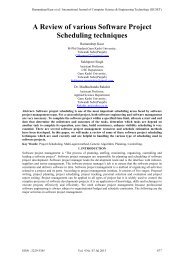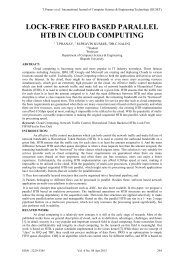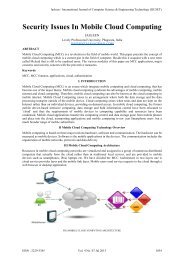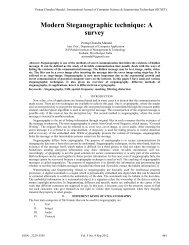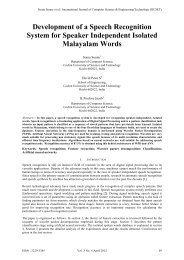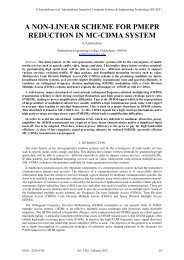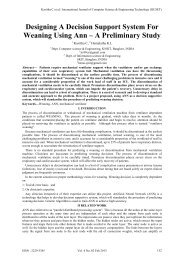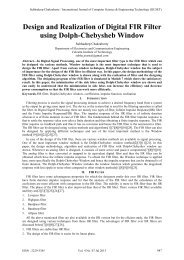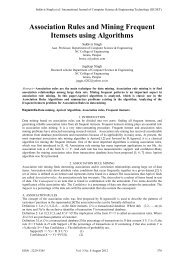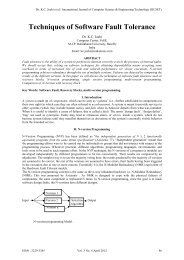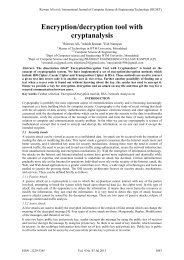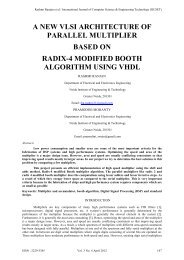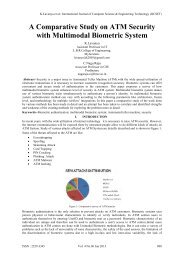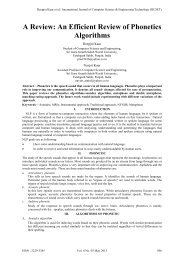An analysis on Stock Market Prediction using Data Mining ... - IJCSET
An analysis on Stock Market Prediction using Data Mining ... - IJCSET
An analysis on Stock Market Prediction using Data Mining ... - IJCSET
Create successful ePaper yourself
Turn your PDF publications into a flip-book with our unique Google optimized e-Paper software.
S.Prasanna et al./ Internati<strong>on</strong>al Journal of Computer Science & Engineering Technology (<strong>IJCSET</strong>)<str<strong>on</strong>g>An</str<strong>on</strong>g> <str<strong>on</strong>g>analysis</str<strong>on</strong>g> <strong>on</strong> <strong>Stock</strong> <strong>Market</strong> Predicti<strong>on</strong><strong>using</strong> <strong>Data</strong> <strong>Mining</strong> TechniquesS.PrasannaSchool of Informati<strong>on</strong> TechnologyVIT UniversityVellore,Indiasprasanna@vit.ac.inDr.D.EzhilmaranSchool of Advanced SciencesVIT UniversityVellore,Indiaezhilmaran.d@vit.ac.inAbstract—<strong>Stock</strong> market data <str<strong>on</strong>g>analysis</str<strong>on</strong>g> needs the help of artificial intelligence and data mining techniques.The volatility of stock prices depends <strong>on</strong> gains or losses of certain companies. Many people c<strong>on</strong>sider stockmarket predicti<strong>on</strong> as gambling. However it is possible to generate c<strong>on</strong>structive patterns by the <str<strong>on</strong>g>analysis</str<strong>on</strong>g> ofstock prices. <strong>Data</strong> mining techniques can be applied <strong>on</strong> past and present financial data to generatepatterns and decisi<strong>on</strong> making algorithms. In this paper we have discussed several attempts made byresearches for stock price predicti<strong>on</strong>. These works show that data mining techniques can be applied forevaluati<strong>on</strong> of past stock prices and acquire valuable informati<strong>on</strong> by estimating suitable financialindicators.Keywords : <strong>Stock</strong> price, inflati<strong>on</strong>, patterns, AI techniques.I. INTRODUCTION<strong>Stock</strong> market is the b<strong>on</strong>e of fast emerging ec<strong>on</strong>omies such as India. Major of capital infusi<strong>on</strong> forcompanies across the country was made possible <strong>on</strong>ly thru shares sold to people. So our country growth istightly bounded with the performance of our stock market. Almost all the developing nati<strong>on</strong>s rely <strong>on</strong> their stockmarket for further strengthening of their ec<strong>on</strong>omy. <str<strong>on</strong>g>An</str<strong>on</strong>g>y way in developing ec<strong>on</strong>omies less than 10% of peopleare engaging themselves with stock market investment fearing the volatile nature of stock market. Many peoplefelt that buying and selling of shares is an act of gambling which is a wr<strong>on</strong>g noti<strong>on</strong>. Majority of financialresearchers agree that stock market is the <strong>on</strong>ly place where investor are getting c<strong>on</strong>sistent inflati<strong>on</strong> beatenreturns for so many years. C<strong>on</strong>sidering the fact of lack of knowledge and awareness across the people stockmarket predicti<strong>on</strong> techniques plays a very crucial role in bringing more people into market as well as to retainthe existing investors. Also the predicti<strong>on</strong> techniques must be treated like astrology or gambling. The appliedtechniques must yield c<strong>on</strong>sistent accurate results with certain level of accuracy always in order change themindset of passive investors.By examining the literature stock market predicti<strong>on</strong> techniques can be grouped into four types. 1)Technical <str<strong>on</strong>g>analysis</str<strong>on</strong>g> approach, 2) Fundamental <str<strong>on</strong>g>analysis</str<strong>on</strong>g> approach, 3) Time series predicti<strong>on</strong> and 4) Machinelearning algorithmic methods. Technical approach is otherwise referred as chartist approach. They aregenerating predicti<strong>on</strong>s based <strong>on</strong> the historical price values of selected stocks. Fundamental <str<strong>on</strong>g>analysis</str<strong>on</strong>g> approach isfinding out the true value of a stock and compares it with the current trading levels and recommends buying ofstock which is traded lesser than its true value. In case of Time series predicti<strong>on</strong> linear flow predicti<strong>on</strong> modelsare generated and historic patterns are traced. Those linear models can be classified into two types based <strong>on</strong>number of variables involved in their estimati<strong>on</strong>. The <strong>on</strong>e variable model is referred as univaraite estimati<strong>on</strong>model and multiple numbers of variables are c<strong>on</strong>sidered in multivariate regressi<strong>on</strong> models. Finally Machinelearning methods c<strong>on</strong>sider set of samples in order to generate linear and n<strong>on</strong> linear patters. The aim is to find outan expressi<strong>on</strong> that can generate the data.Role of data mining in stock marketMany researchers attempts to predict stock prices by applying statistical and charting approaches. But thosemethods lacks behind heavily due to human biased decisi<strong>on</strong>s <strong>on</strong> stock market based <strong>on</strong> day to day mind set ofhuman behavior. By applying data mining in a suitable way hidden patterns can be uncovered which was notpossible by traditi<strong>on</strong>al approaches. Also by applying business intelligence future price predicti<strong>on</strong> with increasedaccuracy levels are possible with data mining techniques. The huge amount of data generated by stock marketsforced the researchers to apply data mining to make investment decisi<strong>on</strong>s. The following challenges of stockmarket can be effectively addressed by mining techniques.ISSN : 2229-3345 Vol. 4 No. 02 Feb 2013 49
S.Prasanna et al./ Internati<strong>on</strong>al Journal of Computer Science & Engineering Technology (<strong>IJCSET</strong>)1) Future stock price predicti<strong>on</strong>2) To generate effective patterns of past data for further <str<strong>on</strong>g>analysis</str<strong>on</strong>g>.3) To optimally utilize the capital of share holders.4) For the growth of country ec<strong>on</strong>omy.5) To bring more investors to stock market who are lacking in <str<strong>on</strong>g>analysis</str<strong>on</strong>g>.6) To stabilize the market.7) To increase transparency in the market.8) To check corruptive practices.9) To bring more lazy and tech savvy investors into market.II. RELATED WORKSPredicti<strong>on</strong> of stock price variati<strong>on</strong> is a very challenging task and the price movement behaves more likea random walk and time varying. In recent times, researchers have used various types of AI techniques to maketrading decisi<strong>on</strong>s. Here, we present a brief review of some of the significant researches. A Sheta [1] has usedTakagi-Sugeno (TS) technique to develop fuzzy models for two n<strong>on</strong>linear processes. They were the softwareeffort estimati<strong>on</strong> for a NASA software projects and the predicti<strong>on</strong> of the next week S&P 500 for stock market.The development of the TS fuzzy model can be achieved in two steps 1) the determinati<strong>on</strong> of the membershipfuncti<strong>on</strong>s in the rule antecedents <strong>using</strong> the model input data; 2) the estimati<strong>on</strong> of the c<strong>on</strong>sequence parameters.They used least-square estimati<strong>on</strong> to estimate these parameters. The results were promising.Ching L<strong>on</strong>g Su et al. [2] have developed a self-organized, five-layer neuro-fuzzy model to model thedynamics of stock market by <strong>using</strong> technical indicators. The model effectiveness in predicti<strong>on</strong> and forecastingwas validated by a set of data c<strong>on</strong>taining four indicators: the stochastic oscillator (%K and %D), volumeadjusted moving average (VAMA) and ease of movement (EMV) from TAIEX (Taiwan <strong>Stock</strong> ExchangeCapitalizati<strong>on</strong> Weighted <strong>Stock</strong> Index). A modified moving average method can be proposed to predict the inputset for the neuro-fuzzy model in forecasting stock price. Simulati<strong>on</strong> results have shown that the model waseffective in predicti<strong>on</strong> and accurate in forecasting. The input error from the predicti<strong>on</strong> of the modified movingaverage method attenuated significantly by the neuro-fuzzy model to yield better forecasting results.M.H. FazelZarandiet al. [3] have developed a type-2 fuzzy rule based expert system for stock price<str<strong>on</strong>g>analysis</str<strong>on</strong>g>. Interval type-2 fuzzy logic system permitted to model rule uncertainties and every membership valueof an element was interval itself. The proposed type-2 fuzzy model applied the technical and fundamentalindexes as the input variables. The model can be tested <strong>on</strong> stock price predicti<strong>on</strong> of an automotive manufactoryin Asia. Through the intensive experimental tests, the model had successfully forecasted the price variati<strong>on</strong> forstocks from different sectors. The results were very encouraging and implemented in a real-time trading systemfor stock price predicti<strong>on</strong> during the trading period.Robert K. Lai et al. [4] have established a financial time series-forecasting model by evolving andclustering fuzzy decisi<strong>on</strong> tree for stocks in Taiwan <strong>Stock</strong> Exchange Corporati<strong>on</strong> (TSEC). The forecasting modelintegrated a data clustering technique, a fuzzy decisi<strong>on</strong> tree (FDT), and genetic algorithms (GA) to c<strong>on</strong>struct adecisi<strong>on</strong>-making system based <strong>on</strong> historical data and technical indexes. The set of historical data can be dividedinto k sub-clusters by adopting K-means algorithm. GA was then applied to evolve the number of fuzzy termsfor each input index in FDT so the forecasting accuracy of the model can be further improved. A differentforecasting model was generated for each sub-cluster. In other words, the number of fuzzy terms in each subclusterwas different. Hit rate applied as a performance measure and the proposed GAFDT model had the bestperformance when compared with other approaches <strong>on</strong> various stocks in TSEC.Shyi-Ming Chen and Yu-Chuan Chang [5] have presented a method for multi-variable fuzzyforecasting based <strong>on</strong> fuzzy clustering and fuzzy rule interpolati<strong>on</strong> techniques. First, the proposed methodc<strong>on</strong>structed training samples based <strong>on</strong> the variati<strong>on</strong> rates of the training data set and then used the trainingsamples to c<strong>on</strong>struct fuzzy rules by making use of the fuzzy C-means clustering algorithm, where each fuzzyrule corresp<strong>on</strong>ded to a given cluster. Then, they determined the weight of each fuzzy rule with respect to theinput observati<strong>on</strong>s and used such weights to determine the predicted output, based <strong>on</strong> the multiple fuzzy rulesinterpolati<strong>on</strong> scheme. They applied the proposed method to the temperature predicti<strong>on</strong> problem and the Taiwan<strong>Stock</strong> Exchange Capitalizati<strong>on</strong> Weighted <strong>Stock</strong> Index (TAIEX) data. The experimental results have shown thatthe proposed method can be produced better forecasting results than several existing methods.WengLuen Ho et al. [6] have proposed an interday financial trading system with a predictive modelempowered by a novel brain-inspired evolving Mamdani-Takagi-Sugeno Neural-Fuzzy Inference System(eMTSFIS). The eMTSFIS predictive model possessed synaptic mechanisms and informati<strong>on</strong> processingcapabilities of the human hippocampus, resulted in a more robust and adaptive forecasting model as comparedto existing ec<strong>on</strong>ometric and neural-fuzzy techniques. The trading strategy of the proposed system was based <strong>on</strong>the moving-averages-c<strong>on</strong>vergence/divergence (MACD) principle to generate buy-sell trading signals. Byintroducing forecasting capabilities to the computati<strong>on</strong> of the MACD trend signals, the lagging nature of theISSN : 2229-3345 Vol. 4 No. 02 Feb 2013 50
S.Prasanna et al./ Internati<strong>on</strong>al Journal of Computer Science & Engineering Technology (<strong>IJCSET</strong>)MACD trading rule can be addressed. Experimental results based <strong>on</strong> the S&P500 Index c<strong>on</strong>firmed thateMTSFIS was able to provide highly accurate predicti<strong>on</strong>s and the resultant system was able to identify timelytrading opportunities while avoiding unnecessary trading transacti<strong>on</strong>s. These attributes enabled the eMTSFISbasedtrading system to yield higher multiplicative returns for an investor.EsmaeilHadavandiet al. [7] have presented an integrated approach based <strong>on</strong> genetic fuzzy systems(GFS) and artificial neural networks (ANN) for c<strong>on</strong>structing a stock price forecasting expert system. At first,they used stepwise regressi<strong>on</strong> <str<strong>on</strong>g>analysis</str<strong>on</strong>g> (SRA) to determine factors which have most influence <strong>on</strong> stock prices.At the next stage, they divided their raw data into k clusters by means of self-organizing map (SOM) neuralnetworks. Finally, all clusters were fed into independent GFS models with the ability of rule base extracti<strong>on</strong> anddata base tuning. They evaluated capability of the proposed approach by applying it <strong>on</strong> stock price data gatheredfrom IT and Airlines sectors, and compared the outcomes with previous stock price forecasting methods <strong>using</strong>mean absolute percentage error (MAPE). Results have shown that the proposed approach outperformed allprevious methods, so it can be c<strong>on</strong>sidered as a suitable tool for stock price forecasting problems.Kelvin Simet al. [8] have proposed a method, 3D subspace clustering to generate rules to pick potentialundervalued stocks. 3D subspace clustering is effective in handling high dimensi<strong>on</strong>al financial data and isadaptive to new data. The obtained results are not influenced by human’s biases and emoti<strong>on</strong>s, and are easilyinterpretable. The c<strong>on</strong>ducted extensive experimentati<strong>on</strong> in the stock market over a period of 28 years (from 1980to 2007), and found that <strong>using</strong> rules generated by 3D subspace clustering algorithms, CATSeeker and MIC,results in 60% more profits than <strong>using</strong> Graham’s rules al<strong>on</strong>e.<str<strong>on</strong>g>An</str<strong>on</strong>g>il Rajput [9] have proposed a rule based classificati<strong>on</strong> method which generates rules withpreprocessed data. It focus <strong>on</strong> each class separately and increases the probability of exact classificati<strong>on</strong>. PRISMalgorithm is applied to generate rules by examining the training data and identifying suitable rules that coversmajority of class. Also it measures the success of each rules. It serves as a suitable tool for generating rules forbuy and sell.Yin S<strong>on</strong>g[10] proposed a method of analyzing coupled behavior of stocks in the market.CHMM(Coupled hidden markov model has been c<strong>on</strong>sidered for coupled relati<strong>on</strong>s in hidden state space. Heproposed a new graph based framework to find out abnormalities that might occur in coupled behaviors. He alsoapply the results to real world stock data and proved that their method beats the basic CHMM markov model inboth technical and business measures.III. CONCLUSIONAs per the discussed works above basically two types of predicti<strong>on</strong> methods are implemented by severalresearches to generate useful extracts. They are fundamental approaches and technical indicator basedapproaches. Many researchers adopted technical indicator approaches <strong>on</strong>ly. Limited work is d<strong>on</strong>e withfundamental approaches which give plenty of opportunity for further research. Since the stock data is highlyvolatile and unpredictable it needs the intelligence of human for effective predicti<strong>on</strong>. Also it needs rigoroustraining of old data for <str<strong>on</strong>g>analysis</str<strong>on</strong>g>. This temperament of stock data makes data mining and AI techniques assuitable <strong>on</strong>ce. Back propagati<strong>on</strong> algorithm for training and suitable AI technique applied <strong>on</strong> some fundamentalapproaches may render promising results. surveyReferences[1] A Sheta, “Software Effort Estimati<strong>on</strong> and <strong>Stock</strong> <strong>Market</strong> Predicti<strong>on</strong> Using Takagi-Sugeno Fuzzy Models”, In Proceedings of the IEEEInternati<strong>on</strong>al C<strong>on</strong>ference <strong>on</strong> Fuzzy Systems, pp.171-178, Vancouver, BC, 2006.[2] Ching L<strong>on</strong>g Su, ChuenJyh Chen and Shih Ming Yang, “A self-organized neuro-fuzzy system for stock market dynamics modeling andforecasting”, WSEAS Transacti<strong>on</strong>s <strong>on</strong> Informati<strong>on</strong> Science and Applicati<strong>on</strong>s,Vol7.8,No.9, September 2010 .[3] M.H. FazelZarandi, B. Rezaee, I.B. Turksen and E. Neshat, “A type-2 fuzzy rule-based expert system model for stock price <str<strong>on</strong>g>analysis</str<strong>on</strong>g>”,Expert Systems with Applicati<strong>on</strong>s,Vol.36, No.1, pp. 139-154,January 2009.[4] Robert K. Lai, Chin-Yuan Fan, Wei-Hsiu Huang and Pei-Chann Chang, “Evolving and clustering fuzzy decisi<strong>on</strong> tree for financial timeseries data forecasting”, <str<strong>on</strong>g>An</str<strong>on</strong>g> Internati<strong>on</strong>al Journal of Expert Systems with Applicati<strong>on</strong>s, Vol.36,No.2, pp. 3761-3773, March 2009.[5] Shyi-Ming Chen and Yu-Chuan Chang, “Multi-Variable Fuzzy Forecasting Based On Fuzzy Clustering and Fuzzy Rule Interpolati<strong>on</strong>Techniques”, Informati<strong>on</strong> Sciences, Vol.180, No.24, pp. 4772-4783,2010.[6] WengLuen Ho, Whye Lo<strong>on</strong> Tung and Chai Quek, “Brain-Inspired Evolving Neuro-Fuzzy System for Financial Forecasting andTrading of the S&P500 Index”, Lecture Notes in Computer Science, Vol.6230, pp.601-607,2010[7] EsmaeilHadavandi, Hassan Shavandi and ArashGhanbari, “Integrati<strong>on</strong> of genetic fuzzy systems and artificial neural networks for stockprice forecasting”, Knowledge-Based Systems, Vol.23, No.8, pp. 800-808,December 2010.[8] Kelvin Sim, Vivekanand Gopalkrishnan, Clift<strong>on</strong> Phua and Gao C<strong>on</strong>g, “3D Subspace Clustering for Value Investing”, IEEE IntelligentSystems, Vol. PP, No.99, pp. 1, 2012.[9] <str<strong>on</strong>g>An</str<strong>on</strong>g>il Rajput , S.P. Saxena , Ramesh Prasad Aharwal and Ritu S<strong>on</strong>i, “Rule based Classificati<strong>on</strong> of BSE <strong>Stock</strong> <strong>Data</strong> with<strong>Data</strong> <strong>Mining</strong>”, Internati<strong>on</strong>al Journal of Informati<strong>on</strong> Sciences and Applicati<strong>on</strong>, Volume 4, Number 1 (2012), pp. 1-9.[10] Xianggao Cai, Su Hu, Xiaola Lin,”Feature Extracti<strong>on</strong> Using Restricted Boltzmann Machine for <strong>Stock</strong> Price Predicti<strong>on</strong>”, 978-1-4673-0089-6/12/$26.00 ©2012 IEEE.[11] Yin S<strong>on</strong>g and L<strong>on</strong>gbing Cao,” Graph-based Coupled Behavior <str<strong>on</strong>g>An</str<strong>on</strong>g>alysis: A Case Study <strong>on</strong> Detecting Collaborative Manipulati<strong>on</strong>s in<strong>Stock</strong> <strong>Market</strong>s”, WCCI 2012 IEEE World C<strong>on</strong>gress <strong>on</strong> Computati<strong>on</strong>al Intelligence June, 10-15, 2012 - Brisbane, Australia.ISSN : 2229-3345 Vol. 4 No. 02 Feb 2013 51



